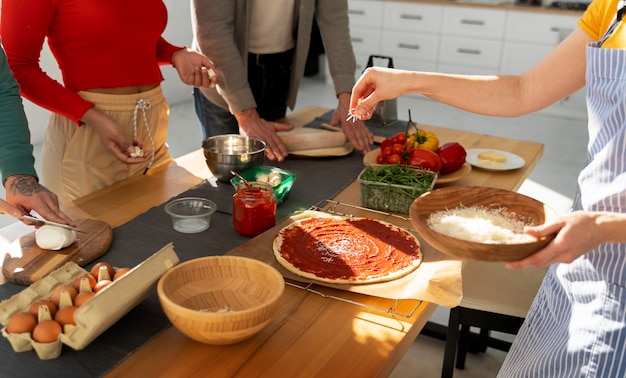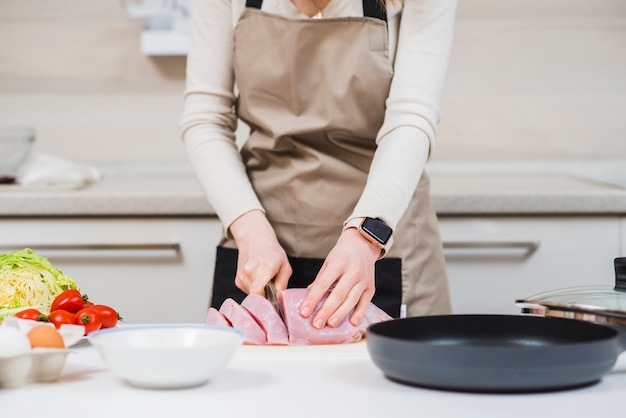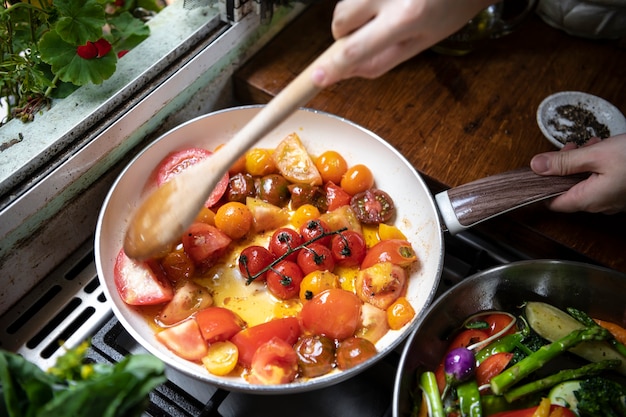Ah, bacon. The breakfast hero, the lunchtime treat, the dinnertime delight. It's a culinary staple that brings joy to every meal, and while everyone has their preferred method, I'm here to champion the art of stovetop bacon. It's a bit of a dance, I'll admit, but when you nail it, the crispy crackle and smoky aroma are simply irresistible.
This guide is your ticket to achieving bacon perfection on the stovetop. We'll cover everything from choosing the right bacon to mastering the flipping technique, with a sprinkle of personal anecdotes and bacon-related wisdom along the way.
Part 1: The Bacon Foundations
The Bacon
Let's start with the star of the show: the bacon. You'll find a world of options out there, each with its unique personality. Thick-cut, streaky, smoked, unsmoked - the choices can be overwhelming! The truth is, there's no "best" bacon, it all boils down to personal preference.
My personal go-to is a thick-cut, streaky bacon. It renders beautifully, yielding a rich, satisfying flavour, and the extra thickness ensures a satisfying chew. However, if you're looking for a leaner option, a thinner cut might be your jam. It's all about finding your ideal balance of flavour, texture, and fat content.
The Pan
Now, let's discuss your cooking vessel, the pan. It's the stage where your bacon will transform into a crispy masterpiece. I've experimented with various pans, and each has its merits.
Cast Iron: Oh, the cast iron. It's a culinary workhorse, getting ridiculously hot and retaining heat like a champion. That's perfect for rendering the fat and achieving those coveted crispy edges. The only downside? It can be a bit of a beast to clean.
Stainless Steel: This is a more user-friendly option, easier to clean and often more readily available. However, it doesn't reach the same scorching temperatures as cast iron, so you might need to cook your bacon a tad longer for that signature crisp.
The Tools
You've got your bacon, you've got your pan, now you need the right tools for the job:
Tongs: These are your partners in crime for flipping bacon. Look for a pair with a good grip, to avoid bacon-covered floors and ensure a smooth flip.
Spatula: You'll need a trusty spatula to scrape up any stubborn bits of crispy bacon. Make sure it's heat-resistant!
Paper Towels: These are crucial for absorbing excess fat. You want that crispy crunch, not a greasy mess.
Part 2: The Commandments of Crispy Bacon

Now, we're getting into the nitty-gritty. My years of bacon-making have taught me a few things, and these commandments are the foundation of my bacon philosophy:
1. Thou shalt not overcrowd the pan. Bacon needs breathing room. If you cram too much in, it will steam rather than crisp up. Give those slices some space!
2. Thou shalt not cook on high heat. Medium heat is the key. You want to slowly render the fat, not burn the bacon. Patience, my friend, is a virtue in bacon cooking.
3. Thou shalt turn the bacon often. This ensures even cooking and prevents sticking. A few flips will help those slices achieve that glorious, uniform crispness.
4. Thou shalt not be afraid of the fat. That glorious, golden fat is what gives bacon its flavour. Don't be shy about draining it off, but don't throw it away! We'll talk about using it later.
5. Thou shalt not overcook the bacon. We want crispy, not burnt. Remember, a little bit of chewiness is a good thing. Keep a close eye on your bacon, and don't be afraid to remove it from the heat if it's getting too dark.
Part 3: The Stovetop Methods

There are several ways to cook bacon on the stovetop, each with its own advantages. I'll guide you through the most popular methods:
The Classic Method
This is the tried-and-true approach, simple and reliable. It's a good starting point for those new to stovetop bacon.
1. Heat a pan over medium heat: Let it get good and hot, but don't let it smoke. You want a consistent heat, not a raging inferno.
2. Add the bacon: Leave some space between the slices so they cook evenly. Don't overcrowd the pan, remember?
3. Cook for 5-7 minutes per side: Flip the bacon halfway through. You'll know it's ready when the edges start to curl and the fat renders out, creating little pools of golden goodness.
4. Remove and drain: Use your trusty tongs to lift the bacon and place it on a plate lined with paper towels to soak up the excess fat. This is where your paper towels become heroes!
The No-Flip Method
This method is all about patience. It's a bit more hands-off, letting the bacon do its thing.
1. Heat a pan over medium heat: Again, let the pan get good and hot, but avoid smoking. Consistency is key.
2. Add the bacon: Lay the bacon flat in the pan, making sure there's space between each slice.
3. Cook for 10-15 minutes, undisturbed: Resist the urge to flip! The bacon will slowly render its fat and crisp up on its own.
4. Flip and cook for another 2-3 minutes: Once one side is crispy, flip the bacon and cook for another 2-3 minutes until it’s cooked through.
5. Remove and drain: Like before, remove the bacon from the pan and place it on paper towels to absorb any remaining grease.
The oven method (sort of)
This method isn't strictly stovetop, but it's incredibly handy for cooking a large quantity of bacon. It's a bit of a cheat, but a delicious one!
1. Preheat oven to 400°F (200°C).
2. Place bacon on a baking sheet lined with foil: Leave some space between the slices.
3. Bake for 15-20 minutes, flipping halfway through. Watch closely, as the bacon can cook quickly.
4. Remove and drain: Place the bacon on paper towels to absorb excess fat.
Part 4: The Bacon-Master’s Toolkit

Okay, let's get into some handy tips and tricks to take your bacon game to the next level. These are the secrets that separate the good from the great.
The Fat-Rendering Trick
This is a personal favourite. It's a bit unconventional, but it can significantly improve the crispiness of your bacon.
1. Cook your bacon as usual: Use whichever method you prefer.
2. Remove the bacon from the pan: Once the bacon is cooked, transfer it to a plate lined with paper towels.
3. Pour the bacon fat back into the pan: Add a tablespoon of water to the pan, and bring the fat to a rolling boil. This creates steam, which helps to crisp up the bacon.
4. Return the bacon to the pan: Cook for another 1-2 minutes until it’s extra crispy.
The Paper Towel Trick
This trick is simple but effective. It helps remove excess fat and prevents the bacon from becoming greasy.
1. Lay a few sheets of paper towels on the bottom of a baking sheet.
2. Place the cooked bacon on top of the paper towels: Don’t overcrowd the sheet.
3. Place another sheet of paper towels over the bacon: This helps absorb any remaining fat.
4. Bake the bacon in a 200°F (95°C) oven for 10-15 minutes: This helps the bacon dry out and become even crispier. You're essentially finishing it off in a low-heat oven, creating a perfect, crispy texture.
Part 5: Beyond the Basics: Flavour and Innovation
We've covered the fundamentals, but why stop there? Let's explore some variations and add-ons to elevate your bacon game to gourmet heights.
The Flavour Infusion
Honey-Garlic Bacon: Add a spoonful of honey and a splash of soy sauce to the pan while cooking. This creates a sweet and savory glaze that's absolutely irresistible. You can even use a basting brush to ensure the glaze coats the bacon evenly.
Maple-Bacon: A classic combination for a reason. Stir in some maple syrup at the end of cooking for a touch of sweetness. You can also experiment with different maple syrup varieties, such as dark or amber, for nuanced flavour profiles.
Spicy Bacon: Add a pinch of cayenne pepper or a sprinkle of red pepper flakes to the pan. It adds a fiery kick to your bacon. Be careful not to overdo it, though, you want to enhance the flavour, not overwhelm it.
The Bacon-licious Sides
Bacon-Wrapped Dates: Stuff medjool dates with a creamy goat cheese filling, wrap them in bacon, and bake until crispy. The sweet dates and creamy cheese are a delicious contrast to the salty, crispy bacon.
Bacon-Wrapped Asparagus: Wrap asparagus spears in bacon and bake until tender and crispy. The bacon adds a smoky, salty flavour to the asparagus, making it a delightful side dish.
Bacon-Cheeseburger: Add a few slices of crispy bacon to your burger for an extra layer of flavour and texture. The smoky bacon adds a dimension of flavour that complements the juicy burger patty perfectly.
The Bacon-Inspired Recipes
Bacon Jam: This sweet and savory jam is made with slow-cooked bacon, onions, and spices. It’s delicious spread on toast, crackers, or used as a burger topping. You can experiment with different spices, such as smoked paprika or chipotle powder, to create unique flavour profiles.
Bacon Carbonara: This classic Italian pasta dish is made with bacon, eggs, and Parmesan cheese. It's a simple yet satisfying dish that showcases the versatility of bacon.
Bacon-Wrapped Chicken: Wrap chicken breasts in bacon and bake until cooked through. It’s a delicious and easy meal that's perfect for a weeknight dinner. You can add other herbs and spices, such as rosemary or thyme, to enhance the flavour of the chicken.
Part 6: The bacon storage Strategies
Alright, you've cooked up a batch of delicious bacon. Now what? Proper storage is key to keeping it fresh and crispy.
Fresh Bacon
Refrigerate: Place the cooked bacon in an airtight container in the refrigerator. It should last for up to a week.
Freeze: For longer storage, freeze the bacon in a freezer-safe bag. It can last for up to three months.
frozen bacon
Thaw in the refrigerator: This is the safest and most recommended method. Place the frozen bacon in the refrigerator overnight to thaw.
Microwave: Use the defrost setting on your microwave to thaw the bacon quickly. Just watch it closely, as it can cook unevenly.
Cold Water: Submerge the frozen bacon in a bowl of cold water. It will thaw fairly quickly, but make sure to change the water every 30 minutes to ensure even thawing.
Part 7: Bacon Bites: A Quick Snack
Sometimes you just crave that crispy bacon goodness. Here are a few quick and easy snack ideas:
Bacon-Wrapped Cheese: Wrap a cube of cheese in a slice of bacon and bake until crispy. You can use various cheeses, such as cheddar, brie, or goat cheese, for different flavour combinations.
Bacon-Wrapped Shrimp: Wrap a skewer of shrimp in bacon and grill until cooked through. This is a simple yet elegant appetizer that's perfect for parties or a quick snack.
Bacon-Wrapped Mini Potatoes: Wrap baby potatoes in bacon and bake until crispy. These are a delicious and satisfying snack that's perfect for game day or a casual gathering.
Part 8: The FAQs
Let's address those burning questions we all have.
1. Can I cook bacon in a microwave?
Yes, you can cook bacon in the microwave, but it won't be the same. It might not be as crispy, and it might not render the fat properly. The microwave is convenient, but it's best to stick to the stovetop or oven for the best results.
2. Why is my bacon always greasy?
The most common reason for greasy bacon is overcooking it. If you cook it too long, it will start to release more fat. Always cook it over medium heat and watch it carefully. Also, make sure to drain the bacon properly on paper towels.
3. What’s the best way to clean my bacon pan?
For cast iron, a good scrub with hot water and a brush is all you need. For stainless steel, simply wash it with soap and water. Don’t worry about getting rid of all the grease, that's what gives your pan its character.
4. Can I use leftover bacon fat for cooking?
Absolutely! Bacon fat is incredibly flavorful and can be used to cook various dishes. It’s perfect for frying potatoes, sauteing vegetables, or even adding a smoky flavour to your scrambled eggs. Store it in the refrigerator and use it within a week or two.
5. What if I don’t like crispy bacon?
Hey, some folks prefer their bacon soft and chewy. If that’s you, cook it for a shorter time over a lower heat. Just keep an eye on it, and you’ll find the perfect level of doneness. It's all about personal preference!
Part 9: The Final Crackle
And there you have it, my bacon-loving friends. We've covered the basics, explored some creative variations, and tackled your burning questions. Now it’s your turn to go out there and experiment.
Remember, the key is to have fun and find what works best for you. Don’t be afraid to try new things, and don’t be discouraged if you don’t get it perfect the first time. Even seasoned bacon chefs have their off days.
So, grab your pan, get your bacon on, and enjoy the glorious crunch of perfectly crispy bacon. Cheers!
Everyone is watching

Corn on the Cob: The Ultimate Guide to Perfectly Cooked Ears
Healthy MealsAh, corn on the cob. Just the name evokes images of sunny days, barbecues, and that sweet, juicy flavour that ...

Perfect Pork Roast Oven Cooking Time: A Guide to Delicious Results
Healthy MealsThere's something truly satisfying about a perfectly roasted pork. The aroma alone is enough to make your mout...

Ham Cooking Time: How Long to Bake, Smoke, or Boil a Delicious Ham
Healthy MealsAh, ham. It's a classic, isn't it? A real crowd-pleaser, especially around holidays. And when done right, it'...

Scallops: The Ultimate Guide to Perfect Cooking
Healthy MealsAh, scallops. Those delicate, sweet, and utterly delicious morsels of the sea. They hold a special place in my...

Spaghetti Squash: The Ultimate Guide to Cooking and Serving
Healthy MealsRemember that time you saw spaghetti squash at the supermarket, looking all bumpy and strange, and thought, "W...
